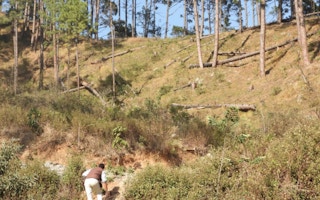For scientist, activist and tree lover Ravi Chopra, it is a painful sight. Where thick forest recently stood, a swathe of bare yellow earth is now dotted with road-building materials and construction workers near his home in India’s Himalayan foothills.
“It’s driving us crazy,” said Chopra, who runs an environmental nonprofit in the city of Dehradun, saying thousands of trees had been cut down due to two recent road-widening projects in the area.
“We’re going to pay a very heavy price for cutting down our forests,” he warned.
Across India, roads, hydroelectric projects and other infrastructure construction took over nearly 83,000 hectares (206,000 acres) of forest land between 2016 and 2021, according to official data.
Nearly 5 per cent of that was protected land, such as national parks.
As development pressures squeeze the country’s established forests, the government says it is committed to boosting overall tree cover through tree-planting in other areas.
It aims to create new plantations by 2030 that can absorb as they grow the equivalent of 2.5 billion-3 billion tonnes of climate-changing carbon dioxide over their lifetime, helping the country meet its commitments on fighting climate change.
But critics say tree planting, or compensatory afforestation as the government calls it, is a poor replacement for the loss of mature forests, even if it does eventually help cut CO2 emissions.
A seven-member expert committee set up by India’s Supreme Court to study the issue urged the government earlier this year to drop the current policy’s emphasis on planting 1,000 trees per hectare.
It said intensive tree plantations “may appear attractive in the short term, but in practice (are) often biased towards fast-growing, non-native tree species that have very limited scope of fostering biodiversity”.
In some places, the policy can lead to ecological and economic harm, the report said. Rather than a one-size-fits-all approach, tree planting must be tailored to the local ecosystem, it concluded.
It cited the example Gujarat state, where an invasive tree had overtaken grasslands that are crucial for cattle and buffalo grazing and a key habitat for wildlife such as the black buck and the great Indian bustard.
Jigmet Takpa, joint secretary at India’s Ministry of Environment, Forests and Climate Change, said the nation had a large population for its size so pressure on land resurces - including forests - was inevitable.
It “has become fashionable to bash the government for destroying the environment every time developmental works are undertaken by the government for the welfare of people,” he told the Thomson Reuters Foundation.
“But we respect the observations made by the experts in the report,” he added, noting they were “worth consideration and worth implementing”.
Losing biodiversity
India is the world’s third-biggest carbon emitter after China and the United States, but the Indian government says the country is making progress on its climate commitments, through measures ranging from a solar energy scape-up to mass tree planting.
In January, the government issued India’s State of Forest Report (ISFR) 2021, which found the country’s forest area had increased by 2,261 square kilometres (872 square miles) in the past two years - an area equivalent to 422,000 football fields.
But by looking only at carbon emissions, the government runs the risk of promoting monoculture plantations that present ecological challenges and can deprive communities of traditional biodiversity related income, said Kanchi Kohli, an environmental policy expert at the New Delhi-based Centre for Policy Research.
“The report, which relies primarily on satellite-based data, has been designed to show compliance with domestic forest policy and international climate mitigation targets,” she said.
It makes no mention of losses of natural forest that impact local economies and biodiversity, Kohli added.
Even in terms of emissions reductions, replacing established forest with intensive new planting doesn’t make sense, said Forrest Fleischman, a forest policy and governance expert at the University of Minnesota.
When mature trees are felled, their carbon-absorbing ability is lost immediately, while newly planted trees take decades to absorb the same amount of planet-warming emissions, said Fleischman, who has worked extensively on northern Indian forest issues.
“This of course assumes that the plantation actually grows, and as our research shows they often do not,” he said.
Threats to newly planted saplings can range from worsening drought and fire to losses to expansion of farming or settlements.
As well, “research shows that plantation forests may never equal natural forests in terms of carbon storage,” he added.
On the steep slopes around Dehradun, in Uttarakhand state, Chopra said the loss of protective forests can exacerbate dangers from heavy rains, as climate change fuels more extreme weather around the world.
Landslides across the state have caused “deaths, injuries and displacement of people” from their homes, Chopra, who runs the Peoples Science Institute, told the Thomson Reuters Foundation.
Such tragedies are testament to the “environmental destruction all around”, he said, warning “tree lovers might soon feel compelled to hit the streets.”
This story was published with permission from Thomson Reuters Foundation, the charitable arm of Thomson Reuters, that covers humanitarian news, climate change, resilience, women’s rights, trafficking and property rights. Visit http://news.trust.org/climate.










